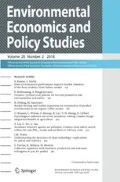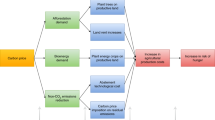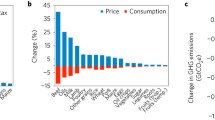Abstract
This study focuses on the links between food production and greenhouse gas emissions in the European Union. The analysis relies on two sets of simulations of AROPAj, a supply-side model of EU agriculture: (i) a carbon price affecting agricultural GHG emissions (from 0 to 200 EUR/tCO2eq), and (ii) a lower limit on the net quantity of food calories provided by EU agriculture (200 to 450 Mt soft wheat equivalent). The model is calibrated on six annual datasets 2007–2012. The results show that a moderate increase in the price of carbon would lead to an increase in total areas and outputs of crops. Animal production decreases over the explored range of carbon price. At 200 EUR/tCO2eq, the reduction in GHG emissions ranges from 25 to 35% depending on the year of calibration. The results also show that current net calorie production from food can be more than doubled, while simultaneously reducing GHG emissions by 10–15%. The compatibility between a reduction in GHG emissions and an increase in food calorie production relies on substantial changes in animal production and feed, which implies significant variations in grassland and fallow land. These effects are contrasted between the regions of the EU.













Similar content being viewed by others
Notes
There are two main ways to introduce carbon pricing: carbon taxes and cap-and-trade systems. Both of these carbon pricing instruments have been presented as an important factor in incentivizing the mitigation of GHG emissions and promoting investment in low emission technologies and practices (OECD and WBG 2015; Kossoy et al. 2015; The Grantham Research Institute 2011).
World Bank data https://data.worldbank.org.
An entire technical presentation of the model is available at https://www6.versailles-grignon.inra.fr/economie_publique/Media/fichiers/ArticlAROPAj.
For a detailed description of FADN data, see: http://ec.europa.eu/agriculture/rica/
Four key variables are used: FADN-defined type of farming (12 TF), altitude (3 levels), irrigation (share of area) and economic size (10 classes).
For each of the years, the model is delineated through more than 1,700 and up to more than 1,900 representative farms.
In AROPAj, the cereal area includes the main cereal crops: durum wheat, soft wheat, barley, maize, oats, rye, and other cereals.
References
Adelphi (2018) The Carbon Tax in Sweden. Technical report, Fact sheet for: Federal Ministry for the Environment, Nature Conservation and Nuclear Safety (BMU)
Aldy JE, Stavins RN (2012) The promise and problems of pricing carbon: theory and experience. J Environ Dev 21(2)
Bajzelj B, Richards K, Allwood J, Smith P, Dennis J, Curmi E, Gilligan C (2014) Importance of food-demand management for climate mitigation. Nat Clim Change 4:924–929
Beddington J, Asaduzzaman M, Fernández A, Clark M, Guillou M, Jahn M, Erda L, Mamo T, Van Bo N, Nobre C, Scholes R, Sharma R, Wakhungu J (2012) Achieving food security in the face of climate change: Final report from the Commission on Sustainable Agriculture and Climate Change. Technical report, CGIAR Research Program on Climate Change, Agriculture and Food Security (CCAFS). Copenhagen, Denmark
Berners-Lee M, Kennelly C, Watson R, Hewitt CN (2018) Current global food production is sufficient to meet human nutritional needs in 2050 provided there is radical societal adaptation. Elem Sci Anth 6(1)
De Cara S, Jayet P-A (2011) Marginal abatement costs of greenhouse gas emissions from European agriculture, cost effectiveness, and the EU non-ETS burden sharing agreement. Ecol Econ 70:1680–1690
De Cara S, Houzé M, Jayet P-A (2005) Methane and nitrous oxide emissions from agriculture in the EU: a spatial assessment of sources and abatement costs. Environ Resour Econ 32:551–583
De Cara S, Henry L, Jayet P-A (2018) Optimal coverage of an emission tax in the presence of monitoring, reporting, and verification costs. J Environ Econ Manag 89:1–13
Deering K (2014) Stepping up to the challenge – Six Issues facing global climate change and food security. Technical report, Copenhagen, Wageningen: CARE, CGIAR Research Program on Climate Change, Agriculture and Food Security (CCAFS), Technical Centre for Agricultural and Rural Cooperation (CTA)
Devereux S, Edwards J (2004) Climate change and food security. IDS Bull 35(3):22–30
European Commission (2009) EU 2009 Report on Policy Coherence for Development. Technical report, European Commission
European Commission (2013) Agriculture in the European Union - statistical and economic information. Technical report, European Commission, Directorate General for Agriculture and Rural Development
European Commission (2014) EU cereal farms report 2013 based on FADN data. Technical report, European Commission
European Commission (2017) EU Agricultural Outlook for the EU Agricultural Markets and Income 2017–2030. Technical report, European Commission
European Environment Agency (2019) Annual European Union greenhouse gas inventory 1990–2017 and inventory report 2019. Submission under the United Nations Framework Convention on Climate Change and the Kyoto Protocol. Technical report, EEA/PUBL/2019/051
European Public Health Association (2017) Healthy and Sustainable Diets for European Countries. Technical report, EUPHA
FAO (2003a) Les bilans alimentaires. Organisation des Nations Unies pour l’alimentation et l’agriculture
FAO (2003b) Trade reforms and food security: conceptualizing the linkages. Technical report, Food and Agriculture Organization of the United Nations
FAO (2009) Food security and agricultural mitigation in developing Countries: options for capturing synergies. Technical report, Food and Agriculture Organization of the United Nations
Foley J, Ramankutty N, Brauman K, Cassidy E, Gerber J, Johnston M, Mueller N, O’Connell C, Ray D, West P, Balzer C, Bennett E, Carpenter S, Hill J, Monfreda C, Polasky S, Rockström J, Sheehan J, Siebert S, Zaks D (2011) Solutions for a cultivated planet. Nature 478:337–342
Frank S, Havlík P, Soussana J-F, Levesque A, Valin H, Wollenberg E, Kleinwechter U, Fricko O, Gusti M, Herrero M, Smith P, Hasegawa T, Kraxner F, Obersteiner M (2017) Reducing greenhouse gas emissions in agriculture without compromising food security? Environ Res Lett 12:105004
Galko E, Jayet P-A (2011) Economic and environmental effects of decoupled agricultural support in the EU. Agric Econ 42:605–618
Garnett T (2011) Where are the best opportunities for reducing greenhouse gas emissions in the food system (including the food chain)? Food Policy, 36
Gerber P, Steinfeld H, Henderson B, Mottet A, Opio C, Dijkman J, Falcucci A, Tempio G (2013) Tackling climate change through livestock - A global assessment of emissions and mitigation opportunities. Technical report, Food and Agriculture Organization of the United Nations (FAO), Rome
Godfray HCJ (2014) The challenge of feeding 9–10 billion people equitably and sustainably. J Agric Sci 152:2–8
Gregory P, Ingram J, Brklacich M (2005) Climate change and food security. Philos Trans R Soc Lond Ser B Biol Sci
Havlík P, Valin H, Herrero M, Obersteiner M, Schmid E, Rufino M, Mosnier A, Thornton P, Böttcher H, Conant R, Frank S, Fritz S, Fuss S, Kraxner F, Notenbaert A (2014) Climate change mitigation through livestock system transitions. PNAS 111(10):3709–3714
HLPE (2012) Food security and climate change. A report by the High Level Panel of Experts on Food Security and Nutrition of the Committee on World Food Security. Technical report, High Level Panel of Experts on Food Security and Nutrition (HLPE)
Huyghe C, De Vliegher A, van Gils B, Peeters A (2014) Grasslands and herbivore production in Europe and effects of common policies. Éditions Quæ
IPCC (2006) 2006 IPCC Guidelines for National Greenhouse Gas Inventories Volume 4: Agriculture, Forestry and Other Land Use. Chapter 5: CROPLAND. Technical report, Intergovernmental Panel on Climate Change
Kossoy A, Peszko G, Oppermann K, Prytz N, Gilbert A, Klein N, Lam L, Wong L (2015) Carbon pricing watch 2015 : an advance brief from the state and trends of carbon pricing 2015 report, to be released late 2015. State and Trends of Carbon Pricing. Technical report, Washington, D.C. : World Bank Group
Leip A, Weiss F, Wassenaar T, Perez I, Fellmann T, Loudjani P, Tubiello F, Grandgirard D, Monni S, Biala K (2010) Evaluation of the livestock sector’s contribution to the EU greenhouse gas emissions (GGELS). Technical report, European Commission, Joint Research Centre
Ludi E (2009) Climate change, water and food security. Overseas Development Institute
McAllister T, Beauchemin K, McGinn S, Hao X, Robinson P (2011) Greenhouse gases in animal agriculture–finding a balance between food production and emissions. Anim Feed Sci Technol 166–167:1–6
Meijl v, Havlik P, Lotze-Campen H, Stehfest E, Witzke P, Domınguez IP, Bodirsky B, Dijk v, Doelman J, Fellmann T, Humpenoder F, Koopman J, Muller C, Popp A, Tabeau A, Valin H, van Zeist W (2018) Comparing impacts of climate change and mitigation on global agriculture by 2050. Environ. Res. Lett., 13(064021)
OECD (2015) Agriculture and Climate Change. OECD, Technical report
OECD and WBG (2015) The FASTER Principles for Successful Carbon Pricing: An approach based on initial experience. Technical report, Organisation for Economic Cooperation and Development (OECD) and World Bank Group (WBG)
Olesen J, Bindi M (2002) Consequences of climate change for European agricultural productivity, land use and policy. Eur J Agron 16:239–262
O’Mara F (2012) The role of grasslands in food security and climate change. Ann Bot 110:1263–1270
Röös E, Bajželj B, Smith P, Patel M, Little D, Garnett T (2017) Greedy or needy? Land use and climate impacts of food in 2050 under different livestock futures. Global Environ Change, 47
Smith P, Haberl H, Popp A, Erb K-H, Lauk C, Harper R, Tubiello FN, de Siqueira Pinto A, Jafari M, Sohi S, Masera O, Böttcher H, Berndes G, Bustamante M, Ahammad H, Clark H, Dong H, Elsiddig EA, Mbow C, Ravindranath NH, Rice CW, Robledo Abad C, Romanovskaya A, Sperling F, Herrero M, House JI, Rose S (2013) How much land-based greenhouse gas mitigation can be achieved without compromising food security and environmental goals? Global Change Biol 19:2285–2302
Smith P, Martino D, Cai Z, Gwary D, Janzen H, Kumar P, McCarl B, Ogle S, O’Mara F, Rice C, Scholes B, Sirotenko O, Howden M, McAllister T, Pan G, Romanenkov V, Schneider U, Towprayoon S, Wattenbach M, Smith J (2008) Greenhouse gas mitigation in agriculture. Philos Trans R Soc B
Sonesson U, Davis J, Ziegler F (2010) Food production and emissions of greenhouse gases - An overview of the climate impact of different product groups. Technical report, SIK - the Swedish Institute for Food and Biotechnology
The Grantham Research Institute (2011) Briefing Note: The case for carbon pricing. Technical report, The Grantham Research Institute on Climate Change and the Environment
Tilman D, Clark M (2014) Global diets link environmentalsustainability and human health. Nature, 515
United Nations (2015) Transforming our world: the 2030 Agenda for Sustainable Development. Technical report, United Nations
van Kernebeek HRJ, Oosting SJ, van Ittersum MK, Bikker P, Boer IJMD (2016) Saving land to feed a growing population: consequences for consumption of crop and livestock products. Int J Life Cycle Assess 21:677–687
Vojtech V (2010) Policy Measures Addressing Agrienvironmental Issues. Technical report, OECD Food, Agriculture and Fisheries Papers, No. 24, OECD Publishing, Paris
West PC, Gerber JS, Engstrom PM, Mueller ND, Brauman KA, Carlson KM, Cassidy ES, Johnston MKG, MacDonald Ray DK, Siebert S (2014) Leverage points for improving global food security and the environment. Science, 345
Wilkes A, Tennigkeit T, Solymosi K (2013) National planning for GHG mitigation in agriculture: A guidance document. Technical report, Food and Agiculture Organization of the United Nations (FAO)
World Bank and Ecofys (2018) State and Trends of Carbon Pricing 2018. Technical report, World Bank, Washington, DC
Acknowledgements
This work benefited from the French state aid managed by the French National Research Agency (ANR) under the “Investissements d’avenir” programme with the reference ANR-16-CONV-0003. It was supported by a grant overseen by the ANR as part of the Programme (LabEx BASC; ANR-11-LABX-0034) and by DIM ASTREA, a regional funding programme funded by Île-de-France authorities “Conseil régional d’Île-de-France”
Author information
Authors and Affiliations
Corresponding author
Additional information
Publisher's Note
Springer Nature remains neutral with regard to jurisdictional claims in published maps and institutional affiliations.
About this article
Cite this article
Isbasoiu, A., Jayet, PA. & De Cara, S. Increasing food production and mitigating agricultural greenhouse gas emissions in the European Union: impacts of carbon pricing and calorie production targeting. Environ Econ Policy Stud 23, 409–440 (2021). https://doi.org/10.1007/s10018-020-00293-4
Received:
Accepted:
Published:
Issue Date:
DOI: https://doi.org/10.1007/s10018-020-00293-4




